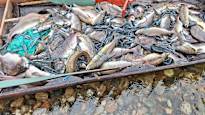Norway is abuzz with the task of removing hundreds of thousands of humpback salmon from the country’s rivers. This year, the focus in Norway is on maximizing the utilization of humpback salmon in the business sector. The Norwegian Broadcasting Corporation (NRK) reports that thousands of humpback salmon have already been caught in Norway. Considered an invasive species, humpback salmon have rapidly spread to the rivers along the northern coast of Norway. Two years ago, over half a million humpback salmon were caught, with a similar catch expected this year. The two-year interval is due to the fact that humpback salmon reproduce every other year, and in Norway, there are only odd-numbered years when humpback salmon spawn.
Anders Tandberg, the department head of Troms and Finnmark County Administration, shares insights on the beginning of the fishing season, which mirrors that of two years ago. He notes, “Based on previous years’ experiences, we expect the first humpback salmon to arrive in the rivers around Midsummer, with the peak growth occurring from mid-July to mid-August.” The Norwegian government has been supporting businesses in Northern Norway to utilize as much of the humpback salmon as possible in an economically viable manner. At least five major fish processing companies have committed to handling humpback salmon that state environmental authorities will be fishing out this summer.
Tandberg highlights the high interest in humpback salmon roe, which is harvested towards the end of summer, around the transition from July to August. He explains, “The quality of humpback salmon meat is at its best in early summer, while the quality of the roe improves as the summer progresses and the fish ascend the river to spawn.” To collect the roe, humpback salmon can be fished in Norwegian rivers using nets and traps. The Norwegian Environment Agency reveals that in 2023, the Norwegian government funded anti-humpback salmon measures in 30 rivers. This year, work is being carried out in 63 rivers. In over 50 rivers, humpback salmon migration is being hindered by dams at the lower reaches of the rivers. In ten other rivers, either net fishing is employed, or fish are captured using fish ladders. The use of fishing dams and nets can begin as soon as the spring floodwaters recede, which, in some cases, may last until the end of July.
The increasing focus on the utilization of humpback salmon in Norway’s business sector reflects not only an environmental concern but also an economic opportunity. As the Norwegian government steps up efforts to manage this invasive species, the collaboration between authorities and businesses is crucial in ensuring sustainable practices. The utilization of humpback salmon not only addresses ecological challenges but also opens up avenues for economic growth and innovation in the fishing industry.
In conclusion, the story of kyttyrälohi in Norway is a multifaceted one, blending environmental conservation with economic interests. The journey of these humpback salmon from invasive species to valuable resource showcases the intricate balance between nature and human intervention. As Norway navigates the challenges posed by these fish, the solutions being implemented underscore the importance of sustainable resource management for the future of both the environment and the economy.









Leave feedback about this